As I write this, we are way, way behind on this blog! Lack of decent internet, a broken camera, international travel and a hectic schedule since arriving back home have all conspired to push blog writing to the bottom of the priority list. Anyway, enough with the excuses, here’s the story of our traverse from Villa O’Higgins to El Chaltén, one of the most famous border crossings in the world, at least in cycling circles, followed by 10 days of hiking and sheltering from the wind and rain in El Chaltén!
We left off in Villa O’Higgins where we were preparing to cross from Chile to Argentina via one of the most fun and adventurous border crossings. It’s only possible on foot and by bicycle and has become a favourite among cyclists despite the hike a bike and logistical challenges it presents.
We ended up spending 4 days waiting in Villa O’Higgins until a weather window opened up to be able to cross the lake. The weather in this region is infamously bad which, combined with the small size of the boats that take hikers and cyclists across Lago O’Higgins, means that crossings rarely ever follow a fixed schedule. They go when they go. Tales of cyclists marooned in this end-of-the-road town with little to do played on our minds, but actually, we ended up having quite a nice time of it! Our little gang of 4 became 5, as we met up with Kim, a German climber and cyclist riding the Carretera (and beyond), who was staying at the same campsite. Elizabeth, a German teenager cycling the Austral as her first ever bike tour and who we’d first met in Coyhaique also turned up a few days in. She promptly sold her bike to a northbound rider and would continue onwards on foot. All in all then, quite a sociable time was had in the common room (literally the owner’s living room) at the Los Pioneros campsite as we waited out the wind and rain. Speaking of the campsite owner, Daniel was also the captain of the boat that we’d be taking across the lake, could speak 3+ languages fluently and had at one time been a pilot in the French Air Force. Quite a character!
Although there’s not much to the town itself, Villa O’Higgins boasts a number of trails that either start from town, or from a short ride down the road, which kept me busy exploring on my morning runs. Best of all and unusually for Chile, these are all completely free. The landscape here felt very wild and untamed, a feeling no doubt emphasised by the rain squalls skidding rapidly across sky. It really did feel like we had reached the end of the road, a place so far from anywhere that one could imagine that there was so much out there still waiting to be discovered. Crossing Lago O’Higgins would mark the end of a major section of our journey – Northern Patagonia – which you could argue started when we headed off from Victoria in search of monkey puzzle trees, way back before Christmas. Ahead of us lay Southern Patagonia, the land of glaciers, vertical rock faces and endless miles of wind-scoured bleakness. All of a sudden and for the first time on this trip, the end was a comprehensible distance away.
And so it was that one a bright Sunday afternoon, we pedalled lazily down the dirt road to the official end of the Carretera and our boat waiting to take use across Lago O’Higgins.



Despite what seemed to be perfect weather, there was still enough wind about to cause a fair bit of chop once we exited the relative shelter of the Brazo Oriental and got out into the middle of the lake, where the wind runs off the Southern Ice Cap unimpeded. Kim was loving it, standing out the back of the boat getting drenched as wave after wave sloshed over the roof of the boat where our bikes were strapped (top tip: put anything you want to keep dry in the hold). Eventually, we pulled into the sheltered cove at Candelaria Mansilla, unloaded our soaking bikes and pedalled 5 minutes to the basic campsite that the family that lives there runs. With incredible views of the sun setting across the lake we gathered to cook our dinner together with our new companieros, enjoying the social company after so long travelling as a solitary pair.
The following day dawned bright and clear. The Chilean border control didn’t seem in any particular hurry us to process us (I suppose you may as well drag the process out for as long as you can otherwise what else are you going to do all day?!) but it was difficult to get annoyed when waiting around just meant more time to soak up the sun and the stunning scenery that encircled us.
From the carabineros, a dirt road climb steeply up to the official border with Argentina, at which point it abruptly runs out. Along the way, we got our first clear view of Mt Fitzroy (known as Cerro Chaltén by the indigenous Tehuelche people). Boy were we glad to have waited out those rainy days in Villa O’Higgins in order to have this perfect day on which to cross the border!
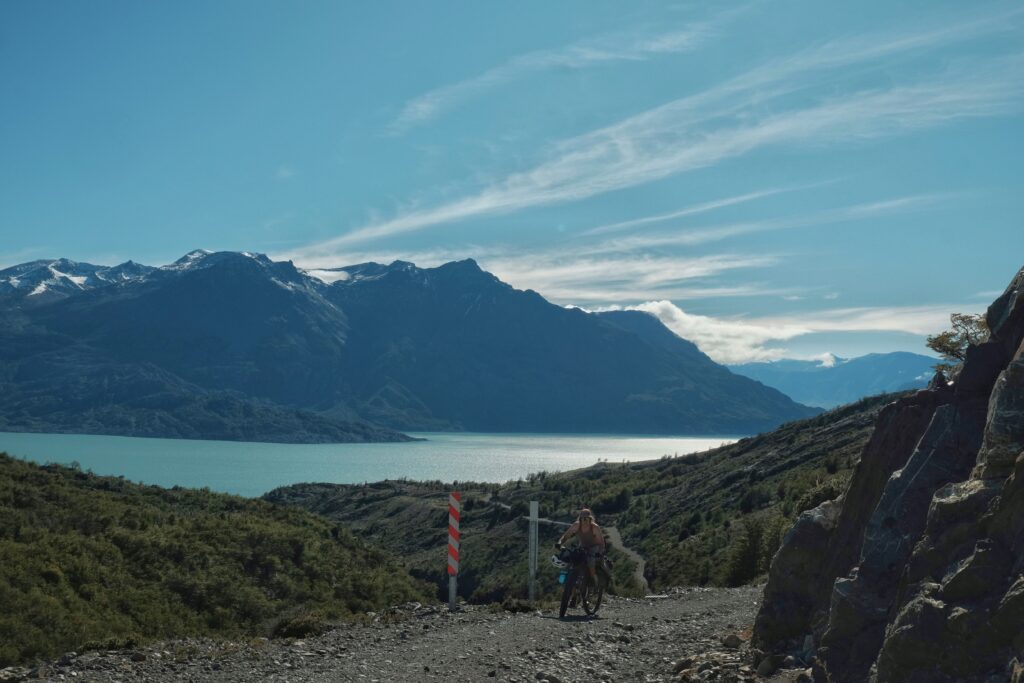
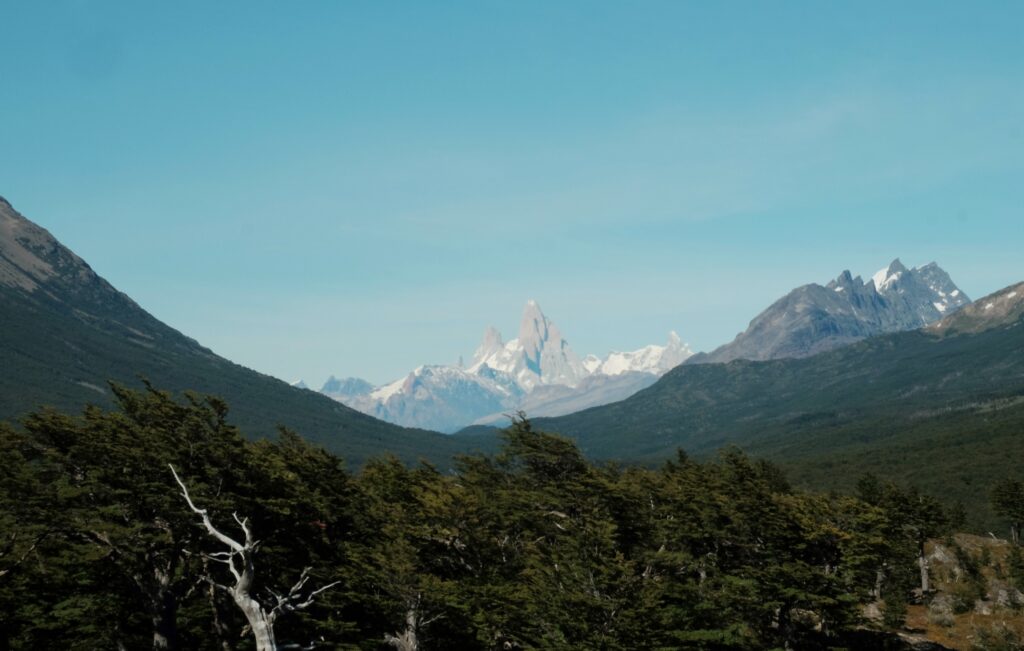

The rest of the way from the imaginary line demarcating Argentina from Chile to the shores of Lago del Desierto is pure singletrack. For some, this section is a slow, frustrating hike-a-bike (imagine taking a tandem, cargo bike or bike trailer along here!!), but for us, with our setups and mountain biking experience, it was some of the best riding of the past few months! Unlike a lot of hiking trails, which are typically tight and a bit awkward to ride, this trail swoops through the trees in lazy turns which seem almost tailor-made for two wheels. Given how many cyclists pass through here each year, this is probably because any tight turns get immediately blown out by bikers overshooting them!

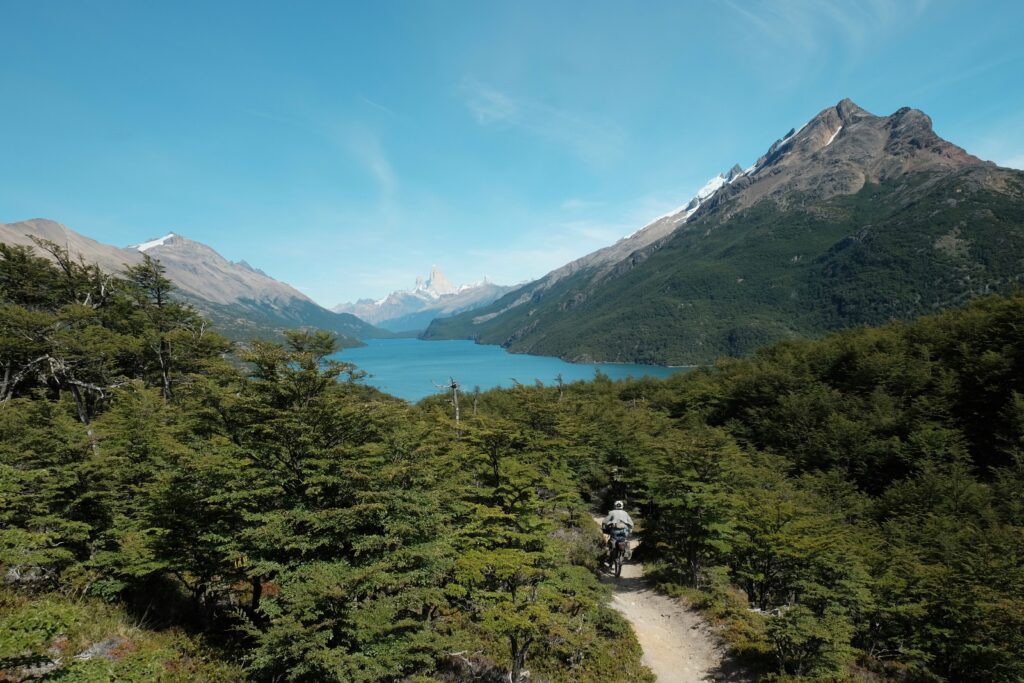
We hit the shore of Lago del Desierto and immediately got our passports stamped by the Argie border control, thinking that we’d get the late afternoon ferry across the lake. However, as more of our gang turned up, the consensus formed that we should stay the night here and get the morning ferry instead. After all, it wasn’t everyday that one got to camp (for free) on the shores of a lake with unimpeded views of the Fitzroy massif in the distance!
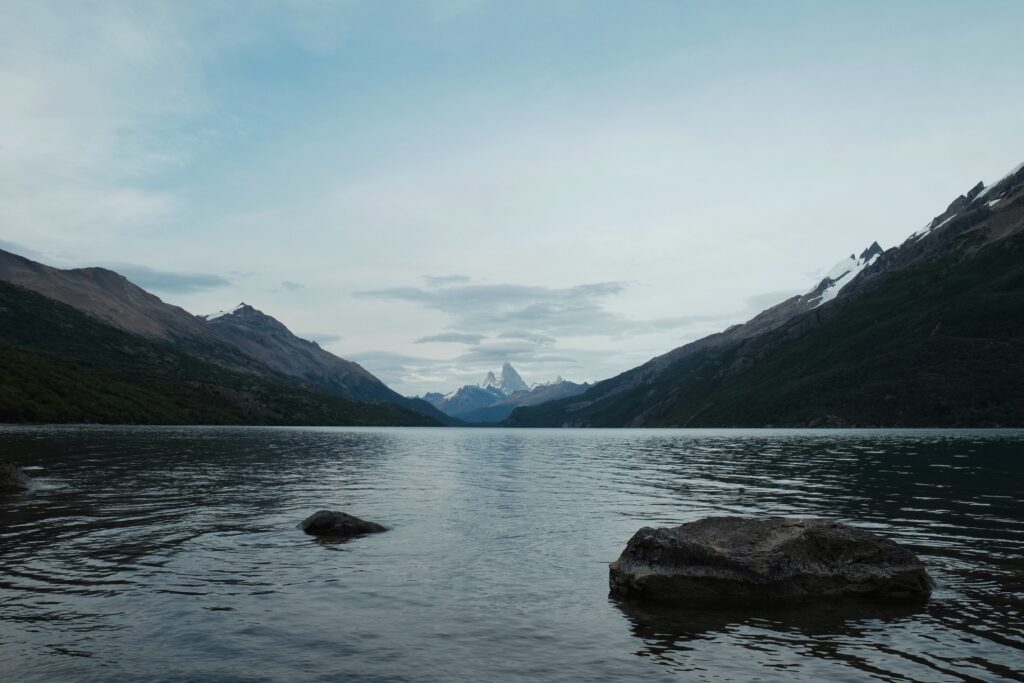
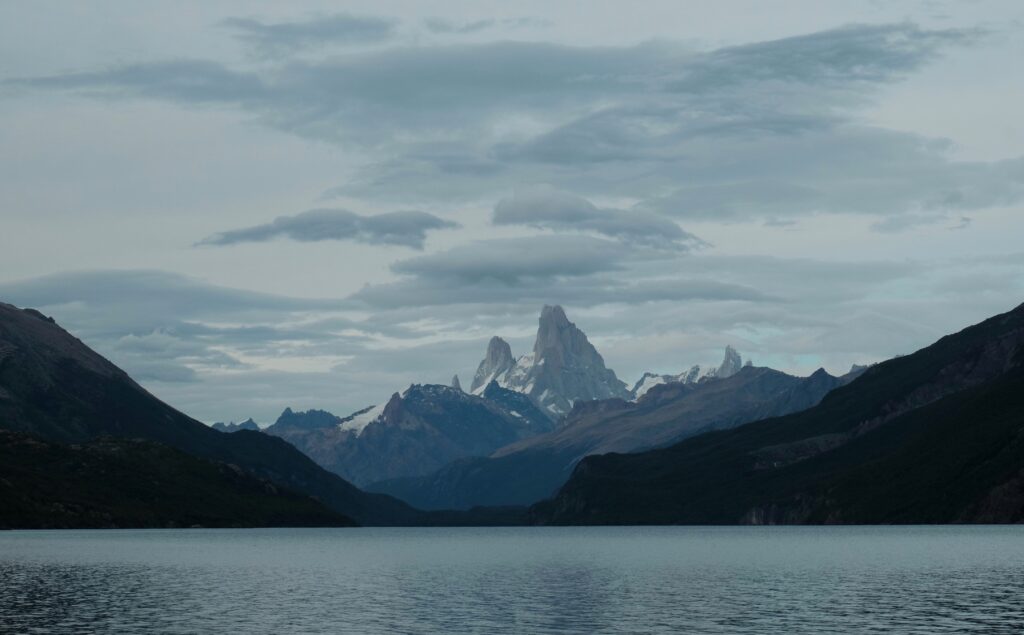
We enjoyed a lazy lie in the following morning waiting for the ferry (supposedly coming any time between 11am and 2pm), soaking up a bit more of the incredible views, although by this stage the sky had started to cloud over. At about 10am, we spotted a boat off in the distance, not thinking anything of it other than it must be some other tourist boat given how early it still was. Closer and closer the boat came, until the realisation dawned that this was in fact our boat! A mad scramble ensued to pack up all our stuff and get it onto our bikes. Maybe this was a sign that we’d fully integrated into South American life and just assumed that everything would be late?! I handed my bike to Pieter, a Belgian backpacker, who would generously chaperoned my bike on the boat while I raced it on foot along the track that follows the Eastern shore of the lake (I lost).
Based on a tip from fellow tourers Suzie and Ed, we didn’t ride to El Chaltén that day, opting to stay at a campsite 10km North of town, a few kilometres from the El Pillar trailhead, which we were promised was slightly quieter than trail that starts from town. Together with Simon and Lizzie, now feeling like our permanent travel companions, we set off the following morning to hike to and from the mirador at Piedras Blancas. It was another lovely day with clear views of the Fitzroy range and everyone had clearly got the same memo – the trail was absolutely heaving! Never before have I seen so many people out hiking and honestly, it did detract from the experience for me. While O’Higgins had felt raw and un-sanitised, the trails here just felt like a tourist conveyor belt. At the mirador, we debated whether to continue on to Laguna de los Tres, or turn back now, eventually deciding on the latter since we didn’t have any lunch with us and wanted to have the afternoon for admin in town. This was a decision that we’d come to regret as it was the last time we would properly see the top of Fitzroy.



The next few days in El Chaltén were spent almost exclusively looking at the weather forecast. Merits of different models were hotly debated, but when they’re all saying the same thing (ie. crap), you’ve got to acknowledge that there might be some truth in the forecast. I managed to sneak off for an early morning run up Lomo del Pliegue Tumbado on the one day it wasn’t actively raining.
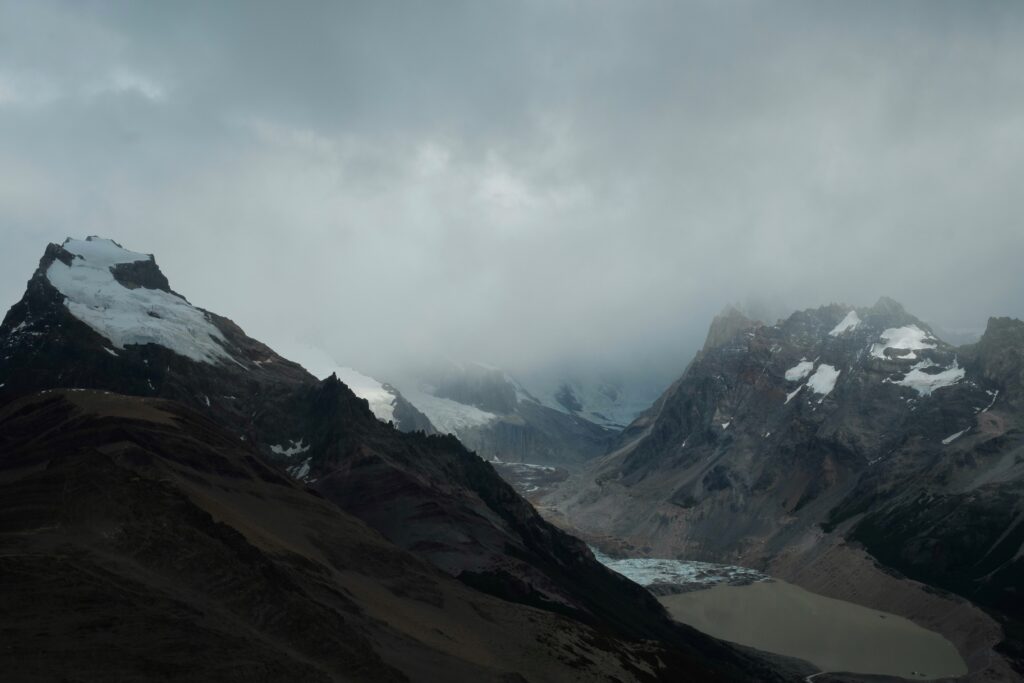
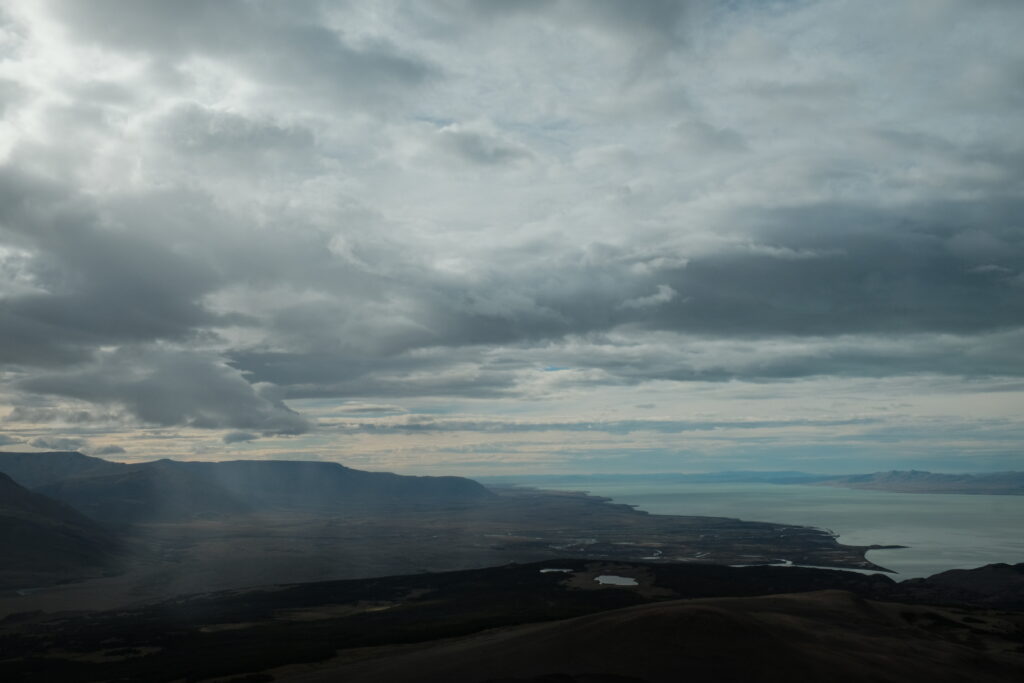

Coming in, our main goal in El Chaltén was to hike the Huemul loop, a 60-ish km trail to the south and west of town that takes walkers right to the edge of the Southern Ice Cap and back along the shores of Lago Viedma. Everything we’d seen and read about this hike reinforced our conviction that it was worth hanging around for. At the first hint that we might get at least one day of reasonable weather on the route, we hired a rucksack for El, a harness to get us across the two tyrolean river traverses and set off the following morning, joined by Simon, Lizzie and Elizabeth (and with Kim not too far behind).
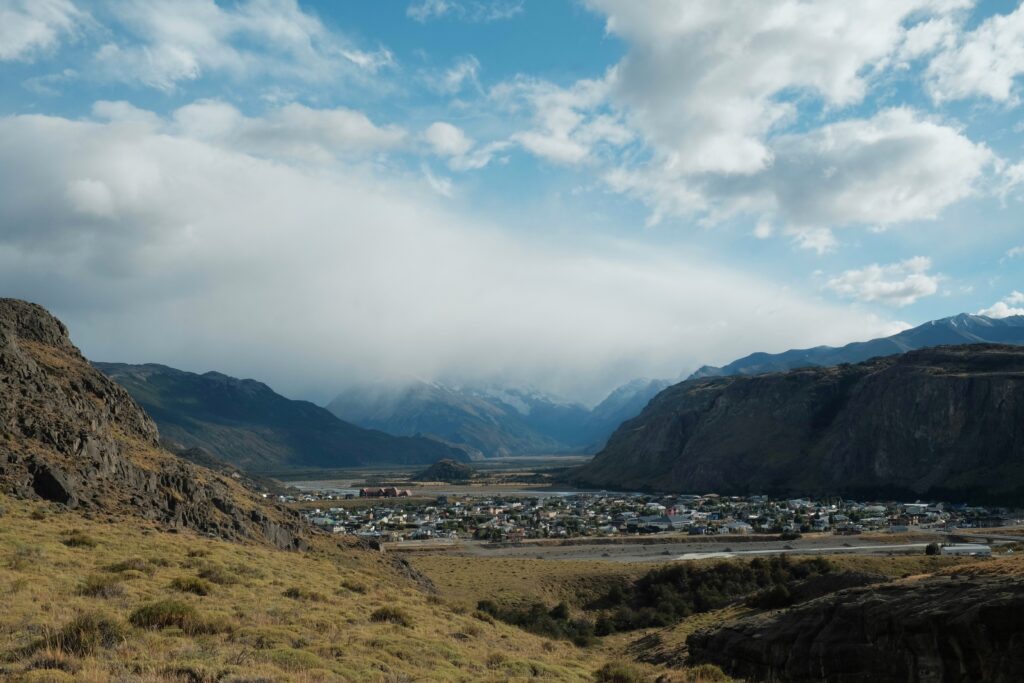
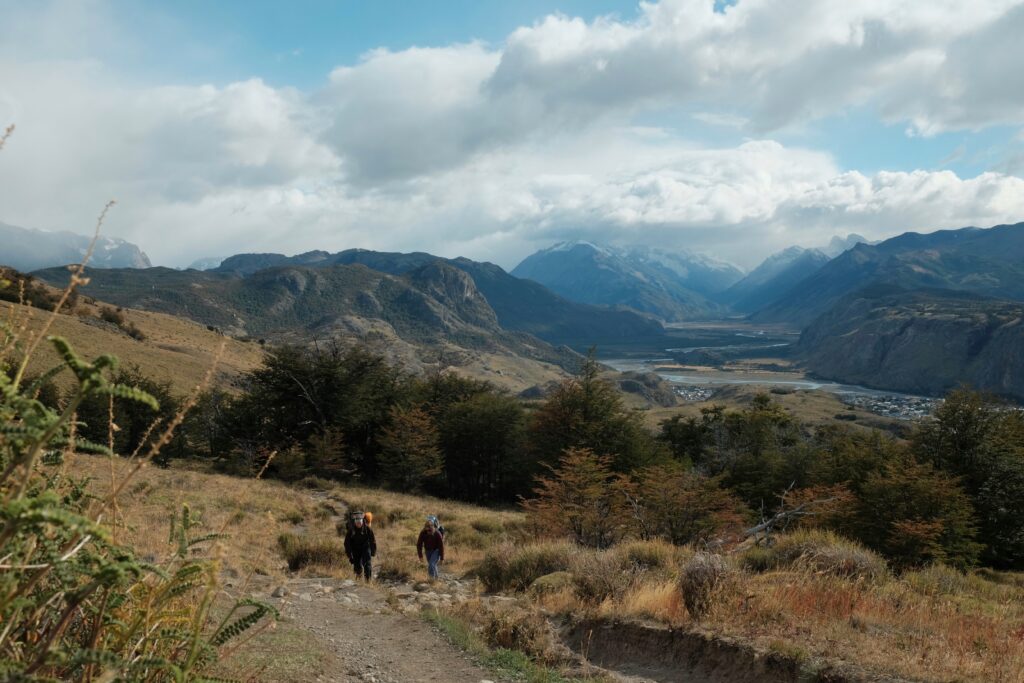
The sunshine in town felt like a distant memory as we ate lunch at the top of the first climb, a light snow drifting down through the trees. As we exited the trees and got our first sight of Túnel river which we would be camping next to that night, things were looking a little ‘moody’ shall we say. We had tried to time the best weather day (or the least bad weather) for the following day, as this would see us climb over Paso del Viento, the most weather dependent part of the route. As such, we weren’t overly concerned as we dropped down into the valley.



The further up valley we proceeded, the stronger the wind got, and by the time we made it to the first campsite on route, it was proper howling. Thankful for the impressive windbreaks that had been created from fallen branches by hikers, we nervously pitched our tents and spent the evening sat in the tiny shelter playing cards.
The sound of successive waves of wind pummelling the trees around us was a constant all night and only seemed to increase in violence as morning approached. A hasty team meeting was convened and we decided that, although we were 90% sure that we’d have to turn around, we’d go up to Laguna Toro just to ‘make sure’. Before we’d even made it around the lake, I think that every member of the party had been knocked to the ground at least once. It was honestly the strongest wind that I’ve ever experienced. The decision to turn back around was a hard one to make given how much we’d built up this trek in our minds, but it was difficult to see how we could safely go any further, with the trail up ahead traversing moraine and glacier where the consequences of getting knocked a couple of feet sideways would be life threatening. With that, we turned around and dejectedly began retracing our steps to town, even eating lunch at exactly the same spot as the day before!
(NB: Kim carried on and, incredibly, managed to make it around the loop despite also copping a bunch of snow on subsequent days. Still, I think that in the moment, we made the right decision.)
Back in town, we re-pitched our tents in the same campsite, a little sooner than we were hoping, and set about forecast scrolling once again. A return to the Huemul trek appeared to be off the cards for the foreseeable, so we contented ourselves with a plan to spend a couple of nights at the two main campsites within the main area of the park. The weather gods were looking down favourably on us as we hiked the Laguna Torre trail to Campamento Agostini, getting a brief glimpse of the elusive summit of Cerro Torre along the way.

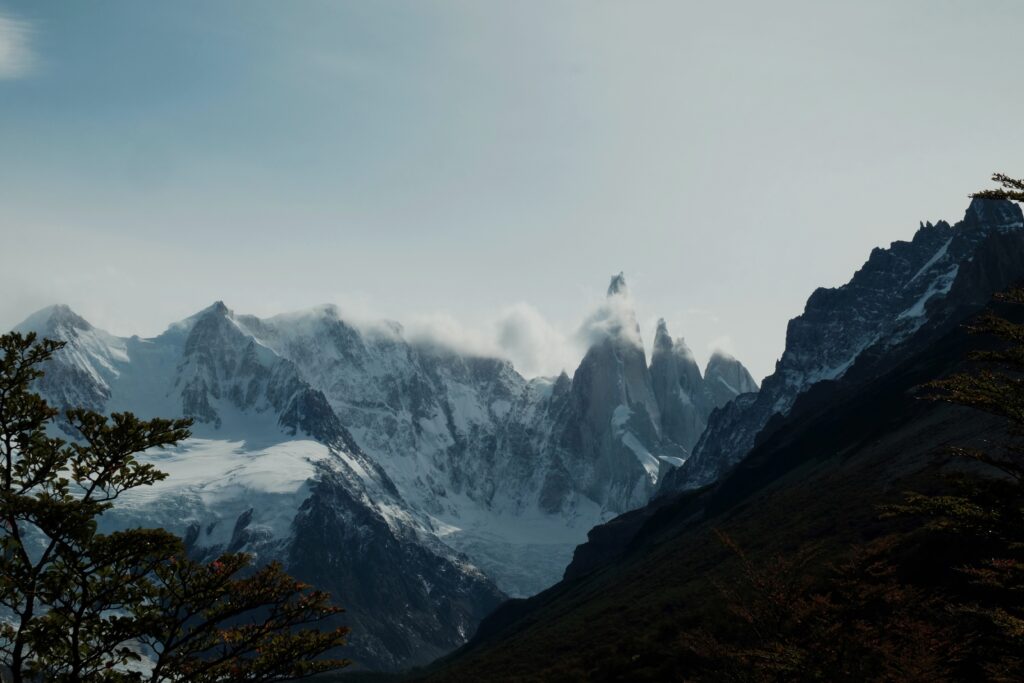
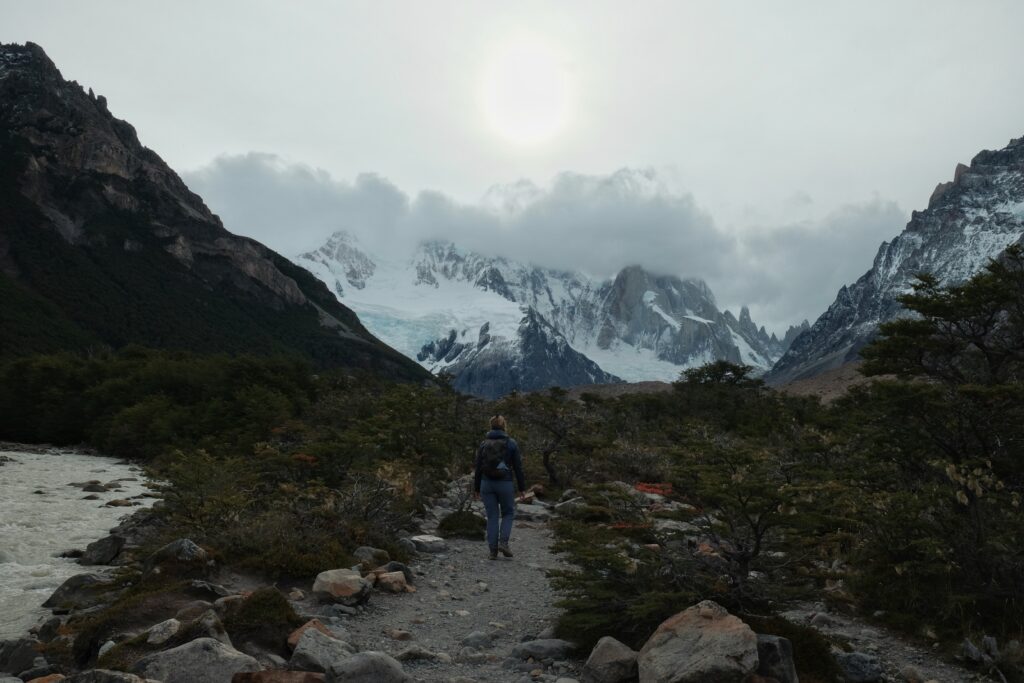
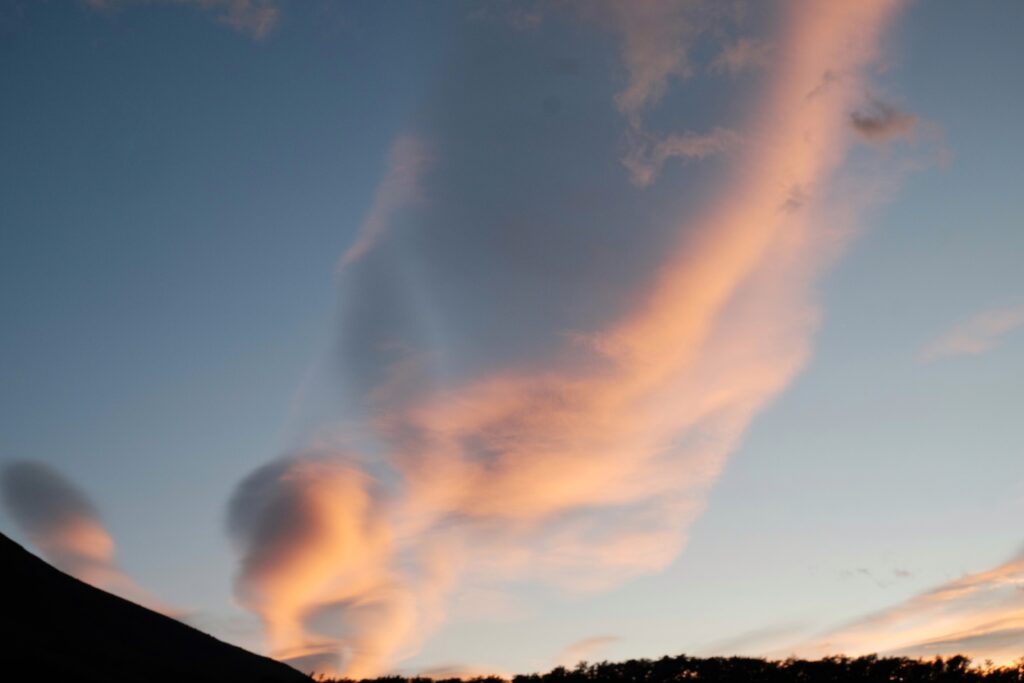


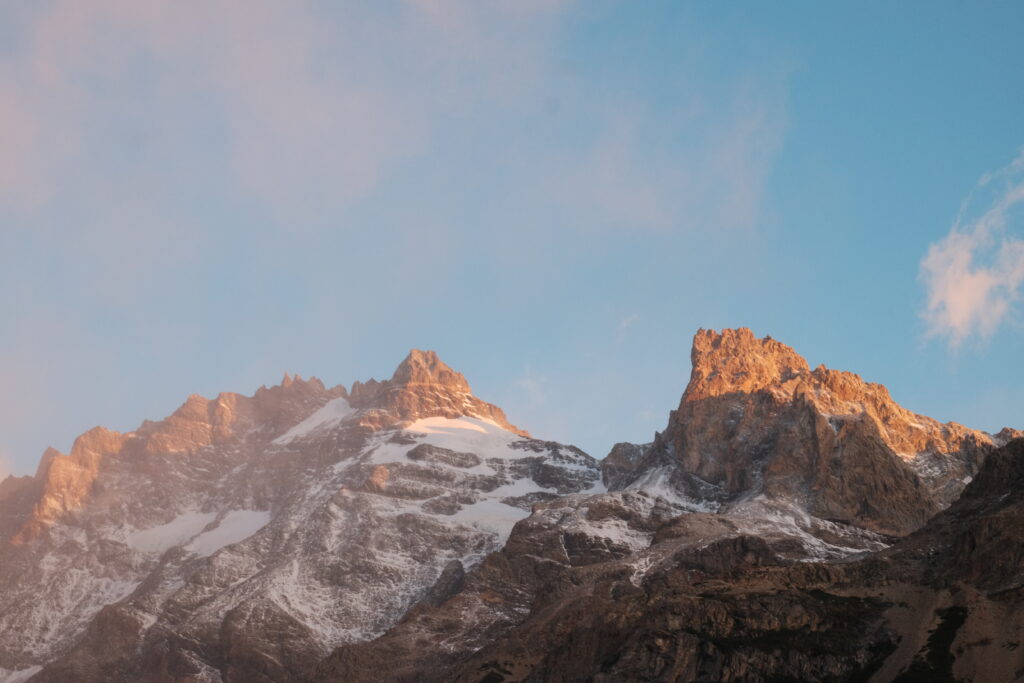


After a promising the start to the day, the weather deteriorated rapidly as we skirted the twin lakes of Laguna Hija and Laguna Madre en route to the Poincenot campsite. By the time we got there, it was full-on raging and we ended up spending the entire afternoon and evening huddled in our tent.
I woke in the night to find myself floating in the tent – our ‘flat’ spot that we had chosen had turned into a pond as the water ran down into it in streams with nowhere to go. Our tent was now sitting on a good 10cm of water! The dirt, having been compacted by the weight of so many tents over the years, had almost no capacity to absorb any of the rain that had been falling heavily for the past few hours. I woke El and together, we used the poo trowel to dig a channel to try and drain the little divot where we had pitched the tent. Half an hour of muddy scraping later, we had succeeded in draining all the standing water from under our tent, but the damage had been done; despite being in a dry bag, my camera had got completely waterlogged.
We hiked back down the Los Tres trail feeling pretty dejected. Despite the awful weather, the trail was still rammed with people going the other way, asking if you could see Fitzroy from where we’d come from. I think the fact that our noses were the only piece of exposed skin was answer enough! In town, we caved and got a private apartment in a hostel together with Simon and Lizzie. The handful of tiny electric heaters in the place were no match for the mountains of sodden kit we had between us, but still, we were just thankful that we didn’t have to spend another night out in ‘that’.
And so, after another day stuck inside with the rain falling and the wind howling outside, we decided to say adios to El Chaltén and continue on the road South. Our ten days there hadn’t delivered the jaw dropping views of granite monoliths and expansive ice fields that we had hoped, but that was how things go sometimes. In retrospect, we’d been so lucky with the weather on so many occasions during our trip, that we reasoned that this was just karma, restoring the natural balance of the world.
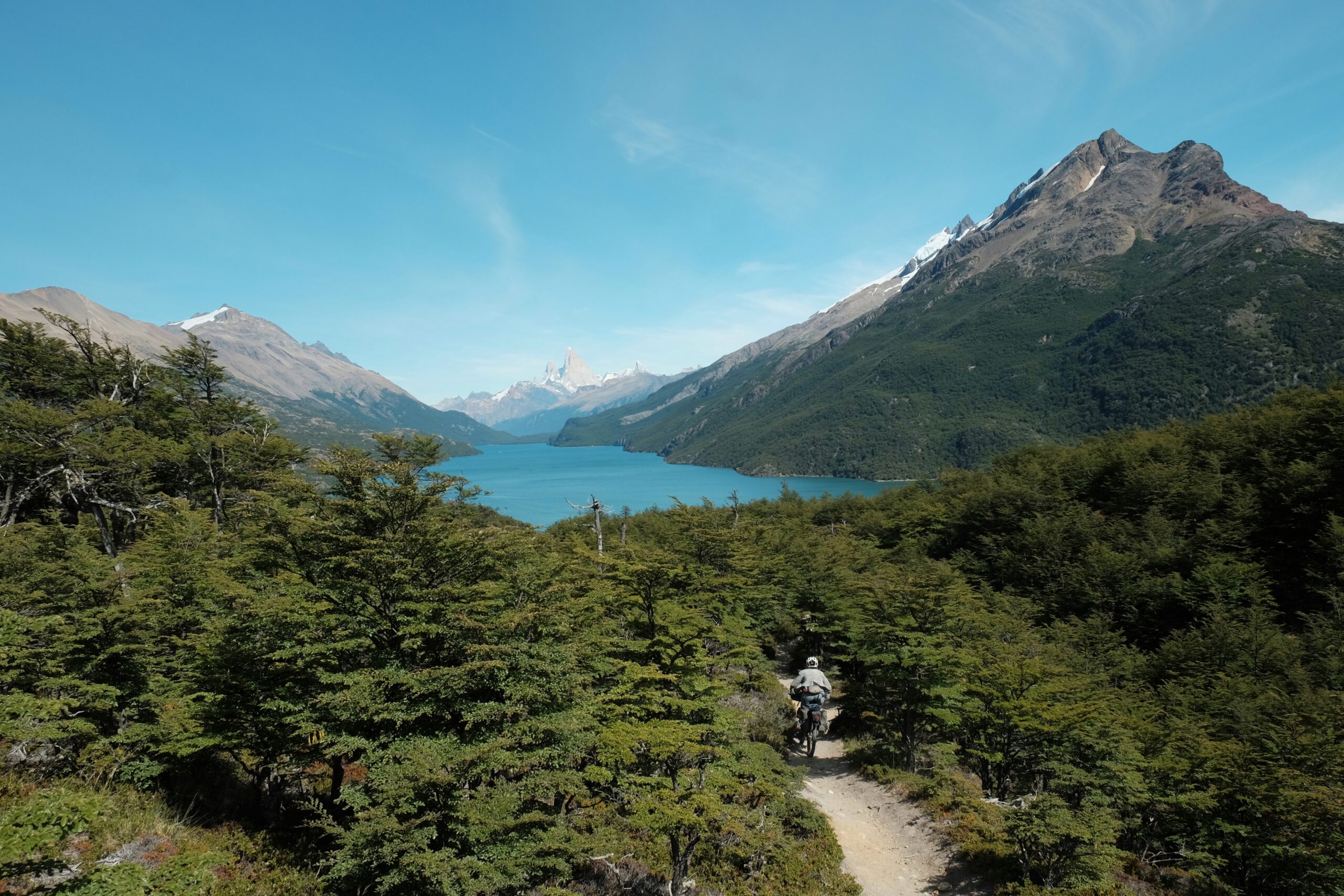
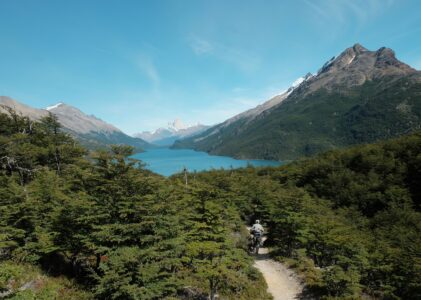
Another great blog, sorry about your camera.